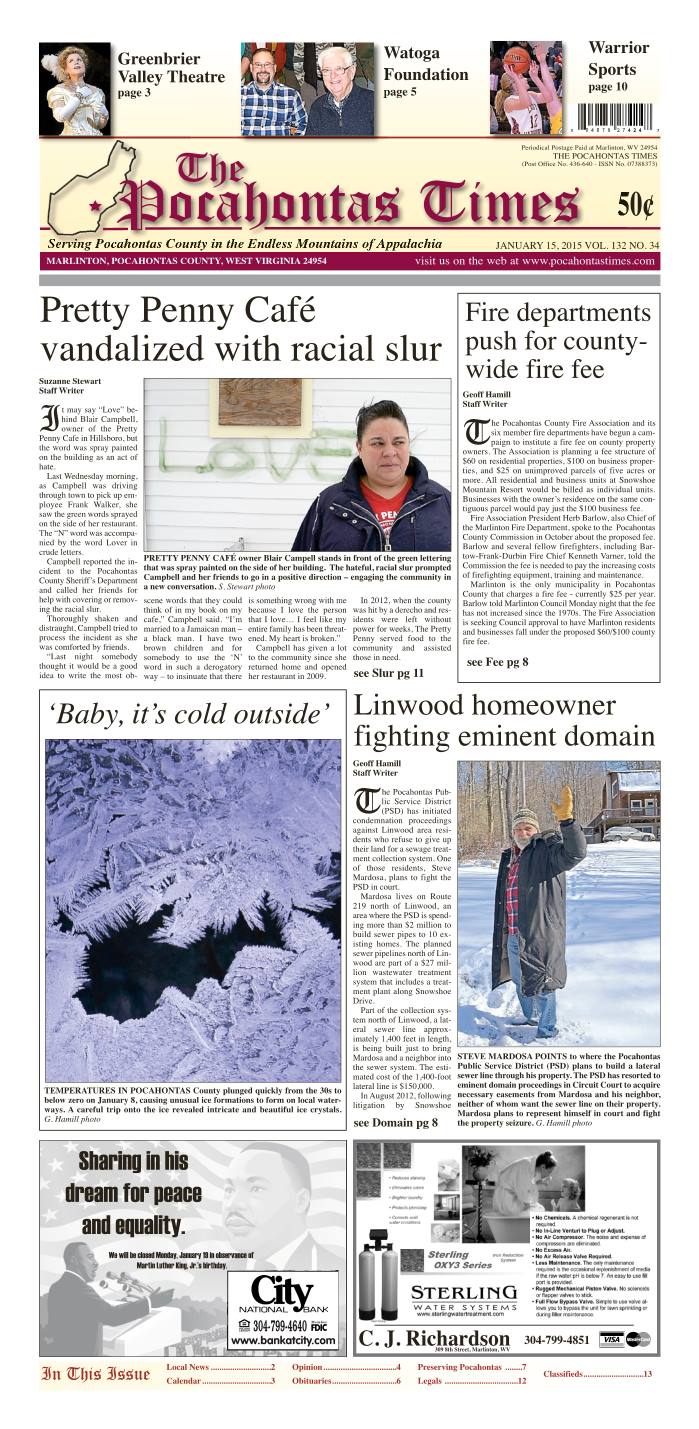
The Pocahontas County Fire Association and its six member fire departments have begun a campaign to institute a fire fee on county property owners. The Association is planning a fee structure of $60 on residential properties, $100 on business properties, and $25 on unimproved parcels of five acres or more. All residential and business units at Snowshoe Mountain Resort would be billed as individual units. Businesses with the owner’s residence on the same contiguous parcel would pay just the $100 business fee.
Fire Association President Herb Barlow, also Chief of the Marlinton Fire Department, spoke to the Pocahontas County Commission in October about the proposed fee. Barlow and several fellow firefighters, including Bartow-Frank-Durbin Fire Chief Kenneth Varner, told the Commission the fee is needed to pay the increasing costs of firefighting equipment, training and maintenance.
Marlinton is the only municipality in Pocahontas County that charges a fire fee – currently $25 per year. Barlow told Marlinton Council Monday night that the fee has not increased since the 1970s. The Fire Association is seeking Council approval to have Marlinton residents and businesses fall under the proposed $60/$100 county fire fee.
An analysis of property records at the Pocahontas County Assessor’s Office shows that the proposed fee would generate approximately $300,000 for the Fire Association each year, including approximately $150,000 from Snowshoe Mountain residence and business owners.
Barlow said the additional revenue is needed to pay the increasing costs of firefighting equipment and training.
“The cost of doing business in the fire service has increased dramatically over the past 20 to 25 years,” he said. “Several years ago, you could buy a new fire truck for $150,000. If you go and order a new engine today, it can be anywhere from $350,000 to $500,000. Your personal protective gear, your turnout gear is a big expense. I’m not going to buy the cheapest version of turnout gear for these guys going into fires. I’m going to buy the top-of-the-line gear to protect them.”
County fire departments face major equipment replacement costs in the near future.
“In Marlinton, two of our trucks were bought after the 1985 flood – they’re 1985 Macks,” said Barlow. “You go out and try to find a set of brakes for a 1985 Mack truck. Once they get so old, it’s hard to find parts for them. If you look around throughout the county, you’ll see the equipment is aging.”
Volunteers firefighters receive extensive training, which the departments provide.
“Training is a big expense,” said Barlow. “To be a firefighter, just to go out and answer calls, you have to be a Level I firefighter. That’s about 120 hours. To be a fire chief, you have to be a Level II firefighter. That about 500 to 600 hours of training, just to be a fire chief. The departments pay for that.”
Barlow said additional revenue from the fire fee would be a significant, but necessary increase for the Fire Association.
“It’s a whole lot more than what we’re getting now,” he said. “The County Commission gives us $50,000 off the hotel/motel tax for the fire service. That’s $50,000 divided by six departments. You do the math – that’s not a lot. You can outfit two to three firefighters with new gear with what you get yearly.”
The State provides limited funding to county fire departments. Barlow said Marlinton Fire Department receives about $20,000 every year from state funds.
County fire departments are mostly volunteer organizations. Marlinton has two full-time employees; Bartow-Frank-Durbin has one full-time employee; and Shavers Fork employs up to eight full-time employees during ski season.
If the County Commission approves the fire fee, Barlow said revenue would be divided by response areas. Fire fees paid by county residents and businesses would go to that resident’s or business’ local fire department. Barlow said firefighter jobs could be created in those local areas.
“It could possibly employ some people, whether it be Frost or one of the smaller departments, ” he said. “There is so much paperwork required on a weekly and monthly basis. It could be full-time or part-time employment for folks. It’s definitely going to make sure that your department in your area will have the proper gear and the proper training.”
Barlow downplays criticism of the proposed fee.
“I understand that $60 is a lot for a lot of people, it’s a lot for me,” he said. “It’s five dollars a month, when you break it down. That’s a pack of cigarettes. That’s a six-pack of beer. It’s barely more than a big bag of Lay’s potato chips.”
The Fire Association is required to collect signatures from 10 percent of qualified voters in the county in order to present a formal request to the County Commission to institute the fire fee. The Association is currently collecting signatures and is expected to present the request to the Commission in the near future.
Barlow promised proper oversight of how fire fee revenue is spent.
“It’s the citizens’ money and we have nothing to hide,” he said. “We have to do an audit through the Fire Marshal Office every year. We have to provide them with an audit. The Town of Marlinton requires us to do a financial statement yearly to present to the town. We’re not buying t-shirts, we’re not having beer and pizza parties or anything like that. The money’s going to a good use.”
Follow-up articles in The Pocahontas Times will profile local volunteer firefighters and examine how other West Virginia counties deal with fire department funding.



